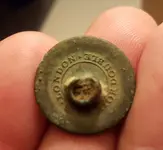D
Deleted member 140734
Guest
- #1
Thread Owner
Today I found this button in an area that has produced a range of artifacts dating from late 1600's, 1700's, an 1820-30's farm site, to early 1900's. I don't know how old this button is but it is interesting to see wool fibers still attached. It was about four inches deep.
I think the well-drained soils of my area help to preserve buried objects. Underneath the topsoil there is often a layer of sand providing good drainage. The colonials in this area were forced to farm around wetlands and lowlands and the higher ground was grazing land. Fortunately they had fishing and shellfish beds to supplement their diet. They named a nearby area Powder Hill because this describes the powdery grayish subsoil with a consistency of dry pulp.
I think the well-drained soils of my area help to preserve buried objects. Underneath the topsoil there is often a layer of sand providing good drainage. The colonials in this area were forced to farm around wetlands and lowlands and the higher ground was grazing land. Fortunately they had fishing and shellfish beds to supplement their diet. They named a nearby area Powder Hill because this describes the powdery grayish subsoil with a consistency of dry pulp.

Upvote
4



